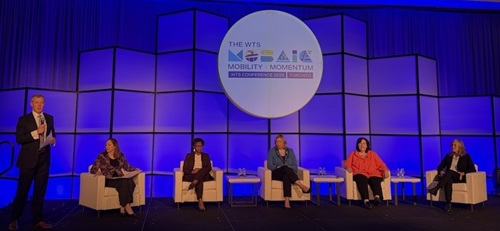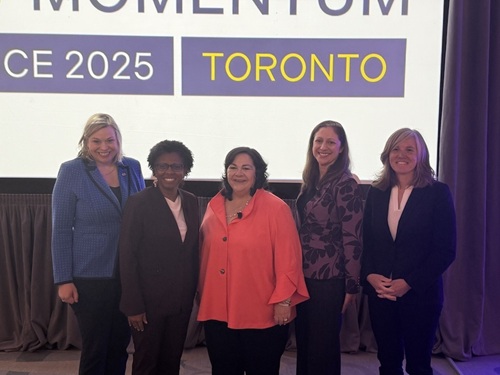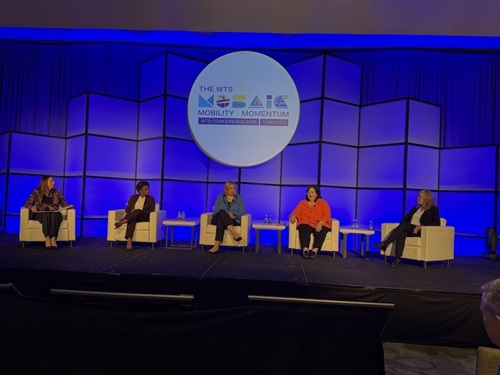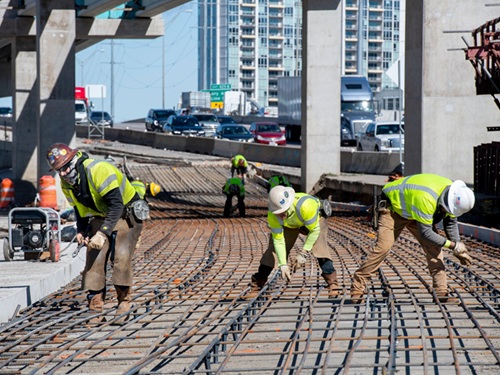The May 8 plenary session at the Women’s Transportation Seminar or WTS International 2025 Annual Meeting in Toronto shared insights from a panel of female state department of transportation chief executives regarding their unique career paths, leadership skills, and how they respond to industry challenges and opportunities.
[Above photo by AASHTO]
That session – entitled “Upward: Advancing Women at U.S. State DOTs” – featured Kristina Boardman, secretary of the Wisconsin Department of Transportation; Shanté Hastings, secretary of the Delaware Department of Transportation; Marie Therese Dominguez, commissioner of the New York State Department of Transportation; and Gia Biagi, secretary of the Illinois Department of Transportation.
All four noted that strong role models – among family and in the workplace – helped convince them to seek leadership roles.

[Editor’s note: The American Association of State Highway and Transportation Officials points out that currently 14 of the chief executives overseeing its 52 state DOT members are women.]
In the case of NYSDOT’s Dominguez, her father – one of the first Latino members of the U.S. Secret Service – convinced her of the worthiness of a career in public service.
Illinois DOT’s Biagi said both her parents and workplace mentors “put me in spaces where I was uncomfortable,” which she said helped prepare her up for future leadership roles.
Wisconsin DOT’s Boardman noted that she found herself “really fortunate” for mentors that “gave me the confidence to move forward to that next level.”
Now, as the first-ever female secretary of the Wisconsin DOT, Boardman said that allows her to, in turn, pay that support forward. “I am very grateful that I can be that person to give them a path … to shoot for the future,” she explained.

Delaware DOT’s Hastings said similar encouragement encouraged her to seek the top job at her agency. “Having worked side by side with previous secretaries, helping them shape the organization and deliver on the missions, I wanted to be part of that,” she stressed. “Not only can I do this, but I want to do this. I want to do it for our people.”
In terms of the opportunities and challenges facing their respective agencies, all four touched on current and future transportation funding needs, as well as workforce recruitment and retention efforts.
“Funding – across the board – is a top issue,” said NYSDOT’s Dominguez. “Given everything that we are looking at in the [surface transportation] reauthorization platform, we need advocacy to make sure that the level of investment established by the IIJA [Infrastructure Investment and Jobs Act] continues and grows. And that means investment in all modes of transportation.”
She also emphasized that none of the benefits of transportation materialize without a dedicated workforce delivering them.
“When I think of priorities, first and foremost, that means investing in our workforce,” Domiguez said. “We have seen such a change in our workforce due to retirements [and] hiring freezes. The level of experience between the senior managers that are retiring now and the group of professionals that are right behind them is a 10-year knowledge gap. That is significant. So, making sure that we are preparing our workforce for the incredible amount of work that they are taking on at much earlier times in careers is primary.”
Filling that gap also means thinking outside the traditional workforce box, stressed Wisconsin DOT’s Boardman.
“We created an Office of Workforce Development [at Wisconsin DOT] that is focused on employee engagement – looking at their entire work experience – so people come to our DOT, we want them to feel welcome and engaged,” she said.
That included setting up formal mentorship and personal development programs, but Boardman noted that “one of the most meaningful things” has been the development of what she called “colleague engagement” networks.
“The first one focused on empowering women in transportation. This happened organically,” she said. “Now we have six groups: One for veterans, LGTBQ, young professionals, legacy professionals that have been here a while, and one acknowledging people with disabilities.”
Illinois DOT’s Biagi said building such workforce connections – particularly among disparate groups – is one her major priorities as well.
“It is about building ‘trust networks’ within our organization and with the communities we work with so can move the needle on things we care about – especially when a crisis develops. We can’t build trust in a vacuum,” she explained. “It is also about thinking about our communities as customers, as clients. That is a cultural shift.”
Those workplace connections are also critical to fostering a culture of “positivity,” Biagi said. “If you show up every day and bring your best self, it cascades throughout the organization. Be a positive person at work and bring people along with you.”
Delaware DOT’s Hastings echoed those thoughts, stressing that “building relationships and credibility with our communities, being data driven, and being good listeners, are very important. We need to understand the experiences that others are having to do our jobs right.”
And “doing our jobs right” means ensuring state DOTs can deliver a multitude of transportation options to all system users, she said.
“We can’t build our way out of [highway] congestion, so that really means increasing multimodal options,” Hastings explained. “We have done a lot with bikes, trains, and sidewalks; making sure we have better transit options, such as offering more micro transit to create convenience for more people. Because, at the end of the day, transportation is about connecting people to opportunity. That is what gets me out of bed every day. That is how I stay positive.”



